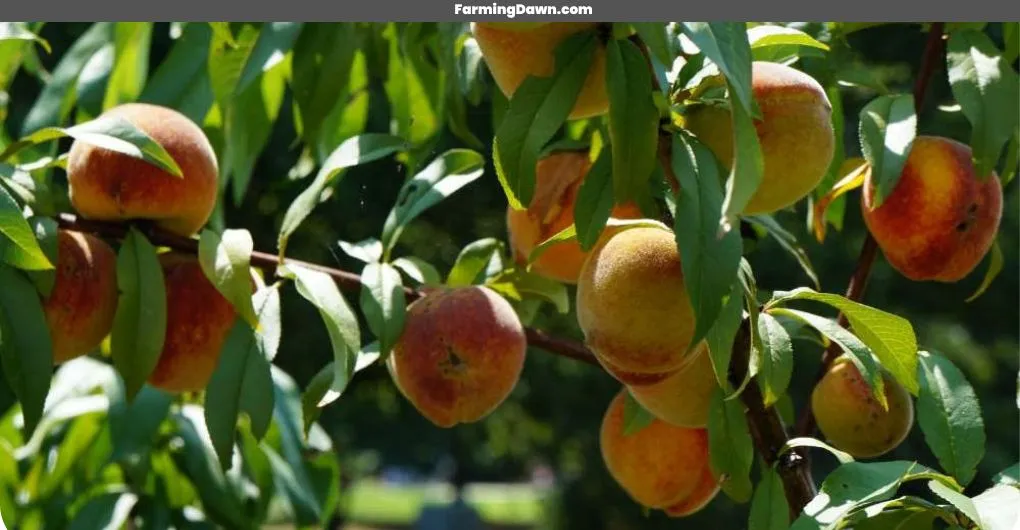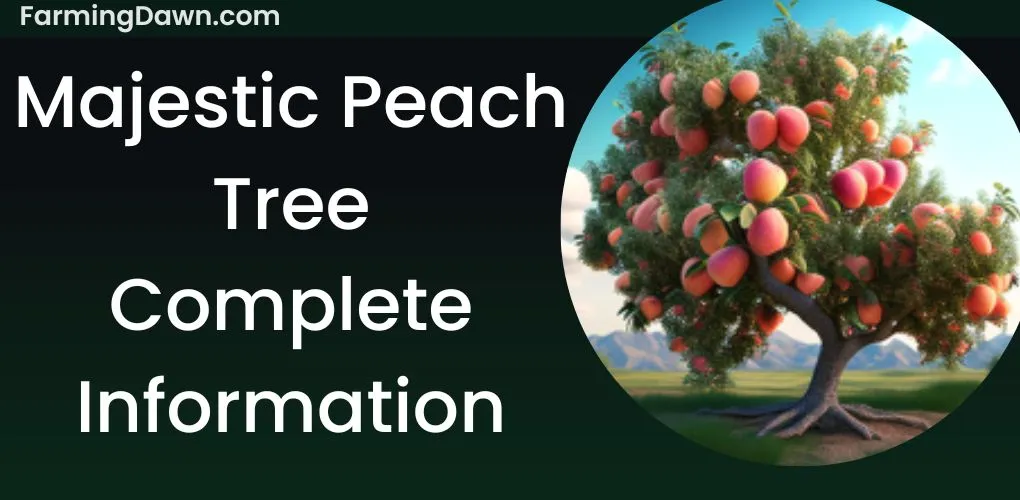The majestic peach tree represents wealth, abundance, and fortune. It’s understandable why this tree has long been a preferred option for gardens and orchards, given its exquisite spring blossoms and abundant fruit in the summer. Today I will give complete information on the majestic peach tree, including characteristics, pollination, propagation, use and caring requirements.
Introducing Majestic Peach Tree
The majestic peach tree is known for its large size, making it ideal for a focal point in your garden or orchard. It has a largest height and width of 20 feet when completely mature. The tree also has a circular canopy of thick, dark-green leaves that offer a lot of summertime shade.
The fruit produced by the majestic peach tree sets it apart from other peach trees. The peaches are enormous and bright reddish-orange. They are also wonderfully juicy and sweet, making them ideal for baking and cooking and for eating raw. The tree is also renowned for its regular and copious fruit output, guaranteeing a stable supply of peaches for years to come.
Physical Characteristics
The majestic peach tree has the following characteristics that set it apart from the following trees:
- Height and Spread
- Leaf Description
- Majestic Peach Tree Bark
- Blossoms
- Fruit
Height and Spread: Majestics normally reach heights of 12 to 15 feet and a spread of 15 to 20 feet. This makes them an excellent option for those looking for a fruit tree that won’t take up too much space in their yard.
Leaf Description: These trees have glossy, bright green leaves. They have an oval form and often reach lengths of 2 to 3 inches. The leaves have a distinctive and lovely appearance due to their slight serration.
Majestic Peach Tree Bark: The Majestic Peach Tree has smooth, gray-colored bark. Its distinctive arrangement of ridges and furrows adds to the tree’s attractiveness.
Blossoms: In the spring, the trees bloom stunning, pinkish-white flowers. These flowers are one of the first signs of spring, and these blossoms draw bees and other pollinators to the tree. The tree is more appealing overall because of the blossoms’ lovely scent.
Fruit: The tree’s fruit is undoubtedly its most prominent feature. This tree produces peaches that range in size from medium to large and have a juicy, sweet flavor. You may eat them straight off the tree or add them to fruit salad.
Majestic Peach Tree Pollination
Several factors affect peach tree pollination, and it is essential to understand them if you want to grow a healthy and productive peach tree.
Understanding the blossoming phase of the peach tree is one of the most essential components of pollination. Peach trees produce flowers in early spring, long before the leaves appear. One of the first indications is spring has arrived in these fragile, lovely blossoms.
The peach tree has complete blossoms, which indicates that they have both male and female reproductive systems. This is distinct from many other fruit trees, which can only produce fruit when cross-pollinated and male or female.
Male flowers start pollinating peach trees by dispersing pollen into the atmosphere. When this pollen reaches the female flowers through the wind, it settles on the stigma and fertilizes the ovules. The fruit grows once the fertilized ovules transform into peaches.
In a perfect scenario, there would be sufficient bees and other pollinators to aid pollination. Sweet nectar from the blooms draws these insects, and as they gather nectar, they also acquire pollen for their bodies. They carry pollen from blossom to flower, allowing the ovules to be fertilized and produce fruit.
See more: Can frost hurt pears on the tree?
Is Majestic Peach Self-pollinating?
Not all peach trees, nevertheless, self-pollinate. Some varieties require nearby neighboring peach trees to aid in the process of cross-pollination to yield fruit. You only need one tree if you have a self-pollinating variety. However, if cross-pollination is necessary for your tree, you must put another peach tree nearby.

15 Majestic Peach Self-Pollinating Varieties
Following is a list of self-pollinating majestic peach varieties:
- Elberta Peach
- Redhaven Peach
- Indian Blood Peach
- Madison Peach
- Sentinel Peach
- Canadian Harmony Peach
- Contender Peach
- Earlystar Peach
- La Feliciana Peach
- Loring Peach
- Monarch Peach
- Nectarine
- Ranger Peach
- Reliance Peach
- Southern Pearl Peach
Will Reliance Peach Trees Pollinate Majestic Peach Trees?
In a nutshell, yes, they can pollinate each other. Reliance and majestic peach trees can cross-pollinate with one another, although both are self-fertile. In fact, many peach tree species can cross-pollinate, so when planting an orchard, it’s crucial to take the date of bloom and the distance between trees into account.
Tips for Effective Pollination
Here are some suggestions to keep in mind to guarantee fruitful pollination between reliance and majestic peach trees:
1) Plant the two kinds next to one another, ideally within 50 feet.
2) Make sure both varieties bloom at the same time. You can use a flowering chart to determine the best time to plant.
3) Encourage bee activity by providing a source of water and avoiding the use of pesticides during bloom.
How To Grow Majestic Peach Tree?
Growing majestic trees can be a rewarding and fun hobby for farmers and common people alike. However, to successfully grow these trees, you need to take into account the following steps:
Climate considerations: Peach trees are native to the tropics of the northern hemisphere and prefer a Mediterranean-style climate with hot, dry summers and moderate, wet winters. They should be placed somewhere that will provide some protection from frost because they are susceptible to low temperatures.
This may mean positioning them in a south-facing, sunny area or constructing windbreaks to block frigid gusts.
Selecting the Best Location: The proper area must be chosen before planting. Peach trees need at least 6 hours of direct sunshine each day because they prefer total sun exposure. They thrive in well-drained soil as well, so be sure to pick a spot where there won’t be any remaining water after a rainstorm.
Additionally, peach trees require a lot of space to expand, so keep them far enough away from other trees and structures.
Getting the Soil Ready: It’s time to get the soil ready after you’ve decided where to plant your tree. Start by excavating a hole that is large and twice as deep as the root ball of the tree. To add more nutrients, mix compost or well-rotted manure into the soil you’ve dug out of the hole.
Establishing the Tree: Your majestic peach tree can now be planted. Remove the tree from its container, then gently pry the roots apart. Put the tree into the hole and add soil, packing it down hard as you go. To help keep the soil moist and discourage weed growth, water the tree well and add a layer of mulch around its base.
How To Propagate Majestic Peach Trees?
Propagating a majestic peach tree is a simple process, and with a bit of care and patience, you can have a full-fledged orchard in no time.
Materials needed
- Peachtree cutting
- Sharp, sterile pruning shears
- Rooting hormone powder
- Plastic bag
- Potting soil
- Plastic container with a lid
- Water
Steps for Propagating
Step 1: Choose a Cutting
The best time to take a cutting from a peach tree is in the late summer or early autumn when the tree is in a dormant state. Choose a fresh, wholesome shoot that is about 6-8 inches long and free of any diseases or pests. Cut the shoot below a leaf node with a sharp, sterile pruning shear.
Step 2: Apply Rooting Hormone
Put rooting hormone powder on the terminal end of the plant to promote root growth. Remove any extra powder by shaking.
Step 3: Prepare a Plastic Container
Fill a plastic container with moist potting soil and make a hole in the center. Ensure the rooting hormone is in contact with the soil before inserting the cutting into the hole.
Step 4: Cover and Moisten
Cover the container with a plastic shopping bag to make a greenhouse-like environment. Make certain that the plastic is in contact with the cutting and soil to hold in moisture. Keep the soil damp but not drenched.
Step 5: Wait and Watch
Put the container somewhere bright but away from the sun. Check for new growth after a few weeks. This indicates that the cutting has taken and roots have developed.
Step 6: Transplant
It’s time to transplant the cutting into a larger container or the ground once it has taken root and new growth has begun to sprout. Make sure to give the new tree plenty of water and fertilizer as it adjusts to its new location.
How To Care For Majestic Peach Trees?
When it comes to caring for these trees, you need to do a couple of things.
Irrigating and watering: For peach trees to flourish and bear fruit, they require constant hydration. Water your tree deeply once a week during dry spells, and make sure the soil is moist but not soggy. If you reside in a dry climate, think about building an irrigation system since this will guarantee that your tree receives the water it requires, even during droughts.
Fertilizing: Regular fertilization is beneficial for peach trees, especially during the growing season. Spring and early summer are the best times to apply a balanced fertilizer.
Pruning: Pruning is a crucial part of caring for peach trees since it shapes the tree, encourages new growth, and boosts fruit yield. Before new growth starts, prune your tree in late winter or early spring. Remove any branches that are crossing or rubbing against one another, as well as any branches that are dead or broken.
To promote a strong central leader, prune back any shoots that are emerging from the tree’s base.
Control of Pests and Diseases: Peach trees are susceptible to a variety of pests and diseases, including peach leaf curl, brown rot, and oriental fruit moth. Keep the area around your tree clear of waste to avoid these issues, as this serves as a habitat for pests.
Additionally, make sure to remove any fallen fruit from the ground since this can draw bugs and serve as a breeding ground for diseases.
Winter protection: To shield the trunk from the chilly wind and sunburn, you can cover it in burlap or tree wrap. You can also add a layer of mulch around the tree’s base to insulate the roots and maintain a more constant soil temperature.
Additionally, it’s a good idea to gently shake the branches to remove any collected snow if you live in a region where there is a lot of snowfall because too much snow might weaken the branches.
Watch My Video On Majestic Peach Trees
How Long Do Peach Trees Live?
The Prunus genus, which also includes fruit trees like cherries and plums, is where peach trees are found. A peach tree’s lifespan is typically 15 – 20 years, although, with reasonable care, some trees can live up to 30 years or longer. The oldest peach tree ever seen lived for more than 100 years and was still bearing fruit until it passed away.
How To Determine The Age Of The Majestic Peach Tree?
One method to estimate the age of a peach tree is based on a cross-section of the trunk’s annual growth rings. This can be done by cutting a small trunk section and counting the number of rings visible.
Another method is to measure the circumference of the trunk at breast height (54 inches from the ground) and use a growth chart to estimate the age based on the trunk size. Additionally, examining the size of the tree, the diameter of its branches, and the overall health and condition of the tree can also provide clues as to its age.
Factors Affecting Majestic Peach Tree Growth
One of the most significant factors impacting the lifespan of a peach tree is the growing conditions it experiences. Trees are more likely to live longer if they are cultivated in soil that drains properly, get enough water and fertilizer, and are shielded from bad weather.
On the other side, trees exposed to harsh weather, too much or too little water, poorly drained soil, or all of these, are more likely to live shorter lives.
The type of tree that is planted can also have an impact on a peach tree’s lifespan. Different peach tree kinds have different levels of hardiness and disease resistance, which can affect how long they live. For instance, the Elberta peach tree is renowned for its sweet fruit but may have a shorter lifespan due to its sensitivity to certain illnesses.
In contrast, the Red Haven peach tree is renowned for its disease resistance and capacity to produce fruit for many years.
The manner in which the tree is pruned and maintained might also affect its longevity in addition to these other variables. Regular pruning can increase a tree’s lifespan by removing sick or broken branches and encouraging healthy growth.
On the other side, ineffective pruning methods, like topping the tree, might harm the tree and shorten its life.
Uses of Majestic Peach Trees
Majestic pech has many uses as a food source or as ornamental value. Some of them are discussed below:
Ornamental Value: Majestic Peach trees are prized for their beautiful pink and white blossoms in the spring, making them a popular ornamental plant in gardens and parks.
Food Source: The sweet, juicy peaches produced by these trees are a popular food source and can be eaten fresh, canned, or used in baking.
Landscaping: Majestic Peach trees can provide shade and serve as an attractive focal point in landscaped areas.
Privacy Screen: A group of peach trees planted together can create a natural privacy screen for outdoor living spaces.
Wildlife Habitat: Peach trees can provide food and shelter for birds, squirrels, and other wildlife, making them a great addition to wildlife gardens.
Erosion Control: The deep roots of Peach trees can help prevent soil erosion on slopes and hillsides.
Air Purification: Like all trees, Peach trees absorb carbon dioxide and other airborne contaminants, improving air quality.
Windbreak: Peach trees can be planted as a windbreak to protect other plants, homes, and other structures from strong winds.
Soil Improvement: The fallen leaves of Peach trees can help to improve soil health by adding organic matter to the soil.
Bonsai: The compact growth habit and attractive flowers of Peach trees make them a popular choice for bonsai enthusiasts.
Majestic Peach Tree: Conclusion
In conclusion, majestic peach trees are a lovely and fruitful addition to any garden. I hope this article gave complete insight into today’s topic’s growing and caring requirements. Hope you liked this article. Thank you!
Each fruit has its unique characteristics and propagation techniques. Read my other articles to learn more:





